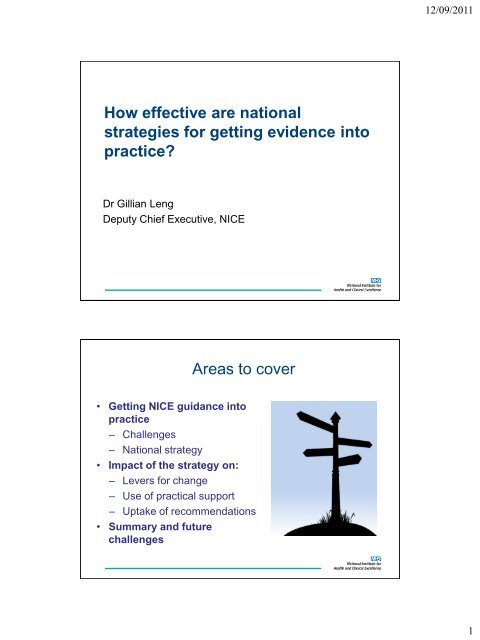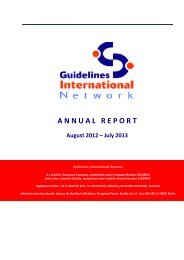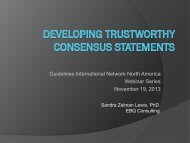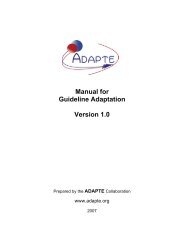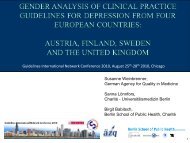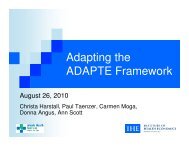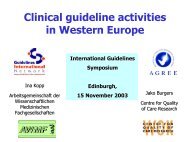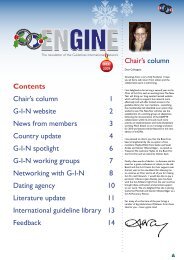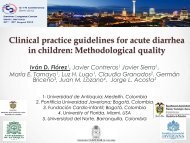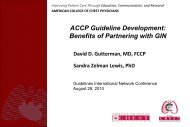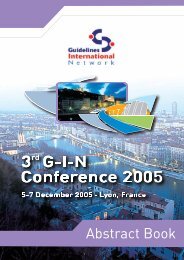Gillian Leng
Gillian Leng
Gillian Leng
Create successful ePaper yourself
Turn your PDF publications into a flip-book with our unique Google optimized e-Paper software.
How effective are national<br />
strategies for getting evidence into<br />
practice?<br />
Dr <strong>Gillian</strong> <strong>Leng</strong><br />
Deputy Chief Executive, NICE<br />
Areas to cover<br />
• Getting NICE guidance into<br />
practice<br />
– Challenges<br />
– National strategy<br />
• Impact of the strategy on:<br />
– Levers for change<br />
– Use of practical support<br />
– Uptake of recommendations<br />
• Summary and future<br />
challenges<br />
12/09/2011<br />
1
Challenges of implementing NICE guidance<br />
Results from 683 clinicians and managers<br />
And we‟ve published a lot of guidance!<br />
Products Numbers<br />
Cancer service guidance 10<br />
Clinical guidelines 113<br />
Interventional procedures 353<br />
Technology appraisals 173<br />
Medical technologies 6<br />
Diagnostics guidance 1<br />
Public health 35<br />
Safety solutions 2<br />
Total 693<br />
Excludes superseded guidance<br />
12/09/2011<br />
2
The NICE implementation strategy<br />
Four principles:<br />
• Raise awareness<br />
– Disseminate and communicate<br />
effectively<br />
• Motivate and encourage change<br />
– Use „levers for change‟<br />
• Provide practical support<br />
– To remove some of the practical<br />
barriers<br />
• Evaluate impact and uptake<br />
– To determine effectiveness of the<br />
strategy<br />
Levels of influence<br />
Individual<br />
components<br />
Organisational<br />
components<br />
External<br />
factors<br />
Individual:<br />
training and<br />
education, audit<br />
and feedback,<br />
performance<br />
assessment etc<br />
Organisational:<br />
leadership,<br />
processes,<br />
planning etc<br />
External:<br />
social,<br />
economic,<br />
political etc<br />
12/09/2011<br />
3
Improved dissemination - NICE pathways<br />
1. To bring together related<br />
guidance, between and within<br />
topics<br />
2. To link other products – audit<br />
tools etc<br />
3. To provide a useful format for<br />
commissioners<br />
4. To improve digital formatting for<br />
easier access via third parties<br />
Easier, quicker access to the<br />
evidence<br />
Navigating pathways<br />
12/09/2011<br />
4
Recommendations appear on the right<br />
Motivating – using „levers‟<br />
Organisational level<br />
• Inspection mechanisms<br />
– Process for guidance use required<br />
• Commissioning<br />
– Use of evidence and indicators in contracts<br />
• Financial incentives<br />
– QoF, tariff etc linked to guidance<br />
• Avoiding litigation<br />
– Lower premia if guidance used<br />
Individual level<br />
• Education<br />
– CPD and revalidation linked to guidance<br />
12/09/2011<br />
5
Generic<br />
• „How to‟ guide<br />
• Forward planner<br />
• Shared learning database<br />
• Field team<br />
Guidance specific, eg:<br />
• Costing tools<br />
• Slides sets<br />
• Audit criteria<br />
• Commissioning guides<br />
Practical support tools<br />
Annie<br />
Coppel<br />
Chris Connell<br />
Stephen Judge<br />
<strong>Gillian</strong> Mathews<br />
Steve Sparks<br />
Evaluating impact and uptake<br />
• Routinely collected national data<br />
• Published research<br />
• Inspection reports<br />
• Patient surveys<br />
• National audits<br />
Deborah Bent<br />
Jane Moore<br />
ERNIE – Evaluation and Review of NICE Implementation Evidence<br />
12/09/2011<br />
6
Impact of the strategy on:<br />
Levers for change<br />
Use of practical support<br />
Uptake of recommendations<br />
Levers: avoiding litigation<br />
• A key function of the NHS Litigation Authority (NHSLA) is to<br />
“contribute to the incentives for reducing the number of negligent or<br />
preventable incidents”.<br />
• The NHSLA aims to achieve this through an extensive risk<br />
management programme.<br />
• Compliance with NICE guidance is the focus of criterion 5.8 Best<br />
Practice – NICE of the NHSLA standards.<br />
– Level 1 - approved documentation for responding to NICE<br />
guidance<br />
– Level 2 - compliance with the approved documentation<br />
– Level 3 - monitoring compliance with the minimum<br />
requirements<br />
12/09/2011<br />
7
Acute trust levels achieved<br />
Levers: financial incentives<br />
The QOF is a voluntary incentive scheme for GP practices in the UK, rewarding<br />
them for how well they adhere to agreed indicators – based on NICE guidance<br />
Example of the national achievement levels for the following QOF indicator:<br />
The percentage of patients age 18 years and over on drug treatment for epilepsy<br />
who have a record of seizure frequency in the preceding 15 months<br />
National achievement for the QOF epilepsy indicator shows levels of achievement<br />
have remained consistently high since the inclusion of the indicator in the QOF<br />
National achievement of the epilepsy indicator<br />
2006/07 95.6%<br />
2007/08 95.6%<br />
2008/09 95.6%<br />
2009/10 95.3%<br />
12/09/2011<br />
8
Practical support: guidance into action<br />
What happens in practice - results from 683 clinicians and managers<br />
Cost impact: informing local business cases<br />
Example: updated guideline on hypertension<br />
Recommended:<br />
If the clinic blood pressure is 140/90 mmHg or higher,<br />
offer ambulatory blood pressure monitoring (ABPM) to<br />
confirm the diagnosis of hypertension<br />
Challenge:<br />
Resistance to this during guideline consultation because<br />
of the additional expense of purchasing new equipment<br />
Need to convince clinicians of the longer term benefits<br />
12/09/2011<br />
9
Cost impact report highlights savings<br />
Initial equipment cost offset by lower rate of diagnosis<br />
£10 000 000<br />
£5 000 000<br />
£0<br />
-£5 000 000<br />
-£10 000 000<br />
-£15 000 000<br />
-£20 000 000<br />
Year 1 Year 2 Year 3 Year 4 Year 5<br />
Change in diagnosis cost Change in treatment cost Net resource impact<br />
Practical tools: do they save time?<br />
Results from a survey of clinicians and managers<br />
12/09/2011<br />
10
Practical tools: do they prompt action?<br />
Results from a survey of clinicians and managers<br />
Uptake of recommendations<br />
Has NICE guidance had any impact?<br />
• NICE has an ongoing programme<br />
of monitoring data on uptake –<br />
from external sources<br />
• Examples of data on uptake for:<br />
– Workplace and public health<br />
– Bariatric surgery<br />
– Diabetes management<br />
– Antibiotic prophylaxis<br />
12/09/2011<br />
11
Uptake of PH guidance for the workplace<br />
Advice on how to improve activity, diet and smoking rates<br />
• An audit of 282 trusts in<br />
England – employ a total of<br />
900,000 NHS staff:<br />
– 32% had a policy to<br />
support physical activity<br />
– 15% had a policy to help<br />
reduce obesity<br />
– 73% had a plan to<br />
support employees stop<br />
smoking<br />
Uptake of guidance on bariatric surgery<br />
Advice to provide surgery in selected cases of obesity<br />
Rate of bariatric surgery (per 100,000 population)<br />
Rate per 100,000 population<br />
8<br />
7<br />
6<br />
5<br />
4<br />
3<br />
2<br />
1<br />
0<br />
TA46: Obesity<br />
(morbid) surgery<br />
(July 2002) -<br />
replaced by CG43<br />
CG43: Obesity<br />
(December 2006)<br />
99-00 00-01 01-02 02-03 03-04 04-05 05-06 06-07 07-08 08-09<br />
Source: HES on-line<br />
12/09/2011<br />
12
Uptake of guidance on diabetes<br />
Percentage of people registered with diabetes who achieved NICE<br />
defined treatment targets – national audit 2009/10<br />
90,00 %<br />
80,00 %<br />
70,00 %<br />
60,00 %<br />
50,00 %<br />
40,00 %<br />
30,00 %<br />
20,00 %<br />
10,00 %<br />
0,00 %<br />
66,50 %<br />
28,20 %<br />
Glucose Control HbA1c<br />
≤ 7.5 per cent<br />
(59mmol/mol)<br />
60,70 %<br />
69,30 %<br />
78,30 %<br />
75,20 %<br />
Blood Pressure 140/80 Cholesterol
…and no change in rates of endocarditis<br />
Proportion of infective endocarditis cases recorded each month with a code for streptococci<br />
or staphylococci as cause.<br />
Red lines represent moving average figure for cases every three months<br />
Thornhill M H et al. BMJ 2011;342:bmj.d2392<br />
©2011 by British Medical Journal Publishing Group<br />
Summary and future challenges<br />
• The evidence for effectiveness of<br />
implementation efforts at a<br />
national level remains imperfect<br />
• NICE will continue to refine its<br />
approach in line with the research<br />
base, and with feedback<br />
• Future challenges for NICE:<br />
– Reorganisation of the English NHS<br />
– New national bodies and „levers‟<br />
– Focus on standards and indicators<br />
– Reduced funding for healthcare<br />
12/09/2011<br />
14
“Change is not made without<br />
inconvenience, even from worse to<br />
better”<br />
Richard Hooker,<br />
1554-1600<br />
12/09/2011<br />
15


